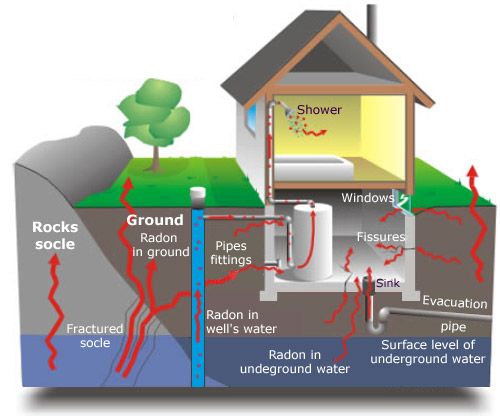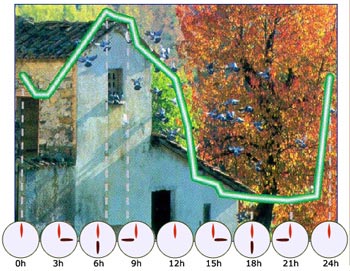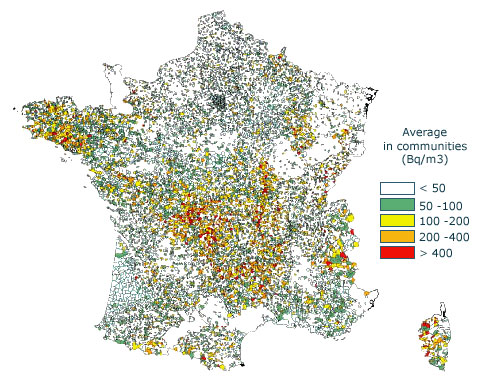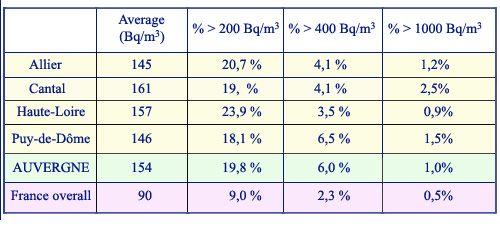Radon may concentrate in homes and buildings

Radon’s pathways into homes
There are a number of different pathways that radon uses to enter inside homes, the most significant of which is through the ground the house is built on. Once inside, radon tends to accumulate in closed, badly-ventilated areas such as attics and cellars. A secondary mode of entry is the water which travels through underground reservoirs.
© IRSN
The radon which makes its way up through the soil will quickly dissipate into the atmosphere once it reaches the surface. The same is not true, however, if radon makes its way into buildings through cracks pores in the walls. Once trapped, it can accumulate and eventually reach significant concentrations. As radon is a carcinogenic substance, it is important to reduce these concentrations and to thereby limit the risk.

Radon daily cycle
Inside a house, the radon concentration varies with the time of day and the lifestyles of the occupants. With the doors and windows closed at night, the radon accumulates. As the shutters open in the morning, the house is ventilated and the gas dissipates.
© IRSN
The radon found in air inside buildings usually comes from the construction materials and from the soil beneath the foundations. Construction materials usually contribute a few tens of becquerels per cubic metre (Bq/m3), whereas the soil can be responsible for several hundred Bq/m3.
The concentration of radon can vary greatly from one region to another as a function of the geological properties of the soil. Granite and shale release relatively high quantities of radon, whereas sedimentary rocks have far lower concentrations. Even within the same geological zone, however, concentrations can vary from one house to another.

Map of radon’s concentrations in French houses
The concentration of radon in the air is measured by the number of disintegrations (becquerels) per metre cubed. This map shows the averages of house’s concentrations carried out in 10,013 French communities. The zones with the highest concentrations surround the granite-rich regions of Massif-Central and Bretagne.
© IRSN
Local conditions can change the concentration of radon found in air, as can the time of day (concentrations are higher in the morning), the season (there is more radon in winter air) and the meteorological conditions.
The most common way in which radon enters a building is through the soil over which the house is built. The further away one gets from the source (the floor, or the wine cellar in older houses), the lower the concentration of radon in air.

Table of radon concentrations
The four French “departments” of the granite-rich Auvergne region have an exposure to radon which exceeds the French national average. The average departemental radon concentrations mask wide disparities. On the basis of measurements carried out by the IRSN, it is estimated that there are 60,000 buildings in France where the concentration of radon exceeds 1,000 Bq/m3 and over 300,000 buildings with a concentration over 400 Bq/m3.
© IRES/IN2P3 (source IRSN)
The infiltration of radon into the home also depends on the way the house was built. Is there a wine cellar underneath? Is the floor made of clay, concrete or cement? How well-insulated are the walls? Are the floors connected with open staircases ? These questions all point out details of construction that influence the concentration of radon in the building.
The concentration of radon in the home also changes with the lifestyle of the occupants. The more powerful and efficient the ventilation, the smaller the risk of having high concentrations. There are simple methods to lower the amount of radon in air: aerate and ventilate the house and the cellars, and improve the insulation in the walls and floor.
In the great majority of cases, these simple measures will be enough. Should a problem arise, detectors can be placed in different parts of the home to pinpoint the source of radon. There are organisations which specialise in monitoring and reducing the concentration of radon in air: the IRSN (the french agency for radioprotection and nuclear safety) in particular carries out such analyses and comes up with potential solutions to problems.